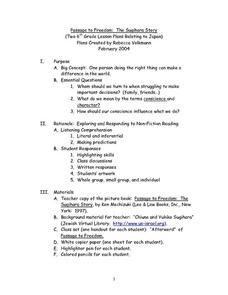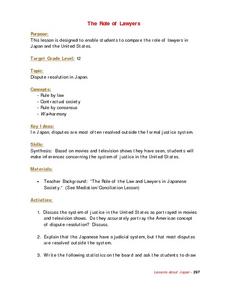Curated OER
Wise Old Woman
Students read "The Wise Old Woman" in class and select a variety of activities related to the story to complete. Activities are separated into C Level, B Level, and A Level activities. Students must complete C Level activities before...
Curated OER
Children in the United States and Japan
Young scholars locate Japan on a map or globe and describe the relative location of Japan. They use the Internet to investigate cultural characteristics of children in the United States and in Japan. They use a Venn Diagram as an...
Curated OER
Life Maps of the Seven Deai Students
Learners inquire about the growing up and dreams for the future of the seven Deai students through photographs and Japanese text. They consider dreams for the future and deepen self-awareness and understanding of others.
Curated OER
Origami Ducks: Geometry, Listening, and Following Directions
Make origami ducks with your class to reinforce geometry concepts and vocabulary; develop fine motor and visual translation skills; and enrich study of Japanese culture, the pond habitat, or migration. Create a whole group "worksheet"...
Curated OER
Volcanoes In Japan
Sixth graders study the characteristics of volcanoes in this unit. They apply the research to the study of three volcanoes in Japan. They complete mapwork, identify indicators of impending volcanic activity, and describe the dangers...
Curated OER
Where Is Japan? What Direction Is It?
First graders locate countries on maps and globes and learn about the hemispheres and the cardinal directions. They listen to books read out loud and dicuss geography.
Curated OER
Thinking About Diversity: One Student's View
Students are asked how would you describe your yourself (Racial/Ethnic). Students read Little Boxes, where it is discussed that the author describes that backgrounds of her parents. They continue to read where they still need to come...
Curated OER
Volcanoes and People
Students discover that volcanic eruptions are geologic events that take place within the upper part and on the surface of the Earth's lithosphere. They explain how volcanoes are related to the Earth's lithosphere. They focus on the May...
Curated OER
Japanese Religion (Shinto)
Fifth graders explore the relationship between the early Japanese religion of Shinto and the natural phenomena of Japan. They engage in Day 3 of the Warlords of Japan simulation.
Curated OER
Noh Theater
Students take a closer look at Japanese drama. In this Japanese culture lesson, students study the attributes of Noh theater and compare it western theater. Students conduct independent research on the art form prior to acting out a Noh...
Curated OER
Dr. Seuss Takes on Charles Lindbergh
Learners study the leaders of the isolationist movement within the United States and the causes of the isolationist movement, they recognize and compare the perceptions of both the isolationists within the US and those who took a more...
Curated OER
Foods and Languages of the World
Students explore cultures around the world. In this cross-curriculum geography lesson, students listen to This is the Way We Go to School , a Book about Children around the World , and locate various countries on the globe and a map....
Curated OER
Passage to Freedom: The Sugihara Story
Sixth graders engage in the reading of a non-fiction text in order to acquire character traits as displayed in the text.The story builds reading fluency through the teacher modeling correct style and speed.
Teacher Created Materials
A Volcano Awakes
Blow your pupils' minds with information about some of the world's most awesome natural occurrences: volcanos. Class members read a short article and respond to included questions. The focus of the resource is on understanding and...
NOAA
Climographs
In the second lesson of a five-part series, young climatologists use provided temperature and precipitation data to create climographs of three different cities. They then analyze these climographs to develop a general understanding of...
Curated OER
Famous People of Japan
Students conduct research to follow several essential questions that guide the instructional activity. The concern of the student research is the finding of contributions of famous Japanese to the culture of the United States.
Curated OER
Tetsuko KUROYANAGI
Students investigate the life and influence of Tet suko Kuroyanagi upon the world. They conduct research into her life from the 1st grade to adulthood. Students read excerpts from her book for information and inspiration.
Curated OER
The Role of Lawyers
Twelfth graders compare and contrast the role of lawyers in Japan and the United States. After viewing movies and television shows, they make guesses about the justice system in the United States. They answer discussion questions and...
Curated OER
The Concept of Wa II
Twelfth graders are introduced to the concept of wa in the Japanese culture. In groups, they compare and contrast the way disputes are handled in both countries. They are given a case in which they state the facts and the issues involved.
Curated OER
The Concept of Wa III
Twelfth graders continue to compare the ways Japan and the United States resolve disputes. In groups, they are given a case in which they apply the concepts of wa to resolve the issues. They predict how the judge in the case dealt with...
Curated OER
Writing Japanese Stories (Grades 6-8)
Students listen to several Japanese stories and write their own Japanese-style stories, which they share with the class.
Curated OER
Who? What? Why Does Your Family Do That?
Students explain that Japanese and Americans have different values concerning behavior, education, and work. They fill out questionnaires which ask about their family practices and compare their answers with Japanese families.
Curated OER
Undokai - Japanese Games
Students are introduced to several traditional Japanese sports and games. Students organize an 'Undokai' - a sports day in which they compete in teams.
Curated OER
Japanese Culture--Comparing the Japanese Educational System to the American
Students study the Japanese educational system and compare and contrast it to the American system. They discuss a typical school day in America and what they believe a typical day is for a Japanese student. Next they write an editorial...

























